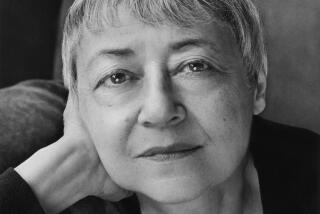Beverly Cleary’s ‘exceptionally happy career’
Reporting from Carmel Valley, Calif. — — Ramona Quimby is everywhere. She’s outside the front door of Beverly Cleary’s retirement community apartment, on a poster that proclaims: “Libraries are forever!” She’s on a sideboard in the living room, in the form of a life-size bust, hair wild and face cut into the shape of a grin.
Most important, she’s on the bookshelf in Cleary’s neat, spare bedroom, along with the author’s other books, 40 or so of them, the work of half a century. Asked which is her favorite character, the 95-year-old doesn’t hesitate. “Well, it must be Ramona,” she says in a low, matter-of-fact voice. “She was just a little brat in ‘Henry Huggins.’ She was sort of an accident because it occurred to me that all the children appeared to be only children. So I tossed in this little sister, and at that moment, a neighbor called out to another neighbor who happened to be named Ramona. So I just named this little girl Ramona. And she kept growing in the Henry books. And my editor said she would like a whole book about Ramona, and I was thinking about it myself.”
There’s a sense of both serendipity and tenacity to such an anecdote, two qualities that define Cleary as well. For many years, she has been an icon — not just of children’s literature but also of American literature, the writer who changed everything with the publication of “Henry Huggins,” her first novel for middle readers, in 1950. In the decades since, she has been a Newbery Medal and Honor winner; she’s a recipient of the National Medal of Arts and has been declared a living legend by the Library of Congress. Ramona has become the mascot for Drop Everything and Read Day, which takes place in libraries and schools each year on Cleary’s birthday, April 12. Later this month, she will receive the Robert Kirsch Award, presented each year to a writer in the American West for lifetime achievement, at the Los Angeles Times Book Prizes.
Yet talking with Cleary, it’s impossible not to connect the writer with the child she once was. Sitting in a comfortable corner chair in her living room, wearing blue pants and a blue sweater, eyes wide behind big glasses, she exudes an air of, if not innocence exactly, then wonder, a delight with the world. “If I don’t enjoy what I’m writing,” she says simply, “I put it in the wastebasket. Because if I don’t enjoy writing it, why would anybody enjoy reading it?” A little later in the conversation, she elaborates: “I’ve had an exceptionally happy career.”
That exceptionally happy career has its roots in Cleary’s early life. Born in 1916 in rural Oregon, she was labeled a problem reader in first grade after her family moved to Portland, the result, she insists, of her first grade Reader, an “incredibly stupid” book. By the time she reached sixth grade, however, she was already thinking she might want to be a writer. “We were assigned to write an essay about a favorite book character,” Cleary recalls, “and I wrote an essay that included a number of favorite characters, and the teacher said that when I grew up I should write children’s books. So I put that in the back of my mind.” Later, as a children’s librarian in Yakima, Wash., in 1939 and 1940, she had another a-ha moment, when “a little boy faced me rather ferociously across the circulation desk and said: ‘Where are the books about kids like us?’”
All these years later, Cleary laughs, remembering this as a flash point in her life. “He had me there,” she goes on, “because there weren’t any. The only one I could find was called ‘Honk the Moose’ by Phil Stong, but it was about farm boys. It wasn’t about town kids. And so I put that in the back of my mind as well.”
What this suggests is a certain single-mindedness, a strength of purpose. But even more essential is Cleary’s identification with younger readers, who she felt were not being served. “Cleary’s unerring sense of the inner lives of children, not to mention animals, continues to speak to kids today,” Susan Patron, former youth services librarian at the Los Angeles Public Library and the author of the Newbery-Medal-winning middle-grade novel “The Higher Power of Lucky,” says in an email. “She showed me that the inner life of any child, the dynamics of family and pets, can be captured as rich, comic, fascinating, poignant, and meaningful.”
For Cleary, the motivation was simple: “I wanted to write,” she says, “about ordinary American children. The books I grew up with and found in the library … so many children lived in England and had nannies and pony carts, and I just wanted grubby neighborhood kids.” This is the secret of Henry Huggins, who — along with Ramona; her big sister, Beezus; and the other residents of Portland’s Klickitat Street — centers so many of Cleary’s books: that in their stories, generations of children have seen themselves. “They’re full of humor, they’re full of heart,” points out Sharon Hearn, who for 25 years has owned the Los Angeles’ store Children’s Book World. “The emotional life of children doesn’t really change, and she has always addressed that with great skill.”
For all that children may not be fundamentally different, the world has changed since Cleary began writing, becoming a harsher, less forgiving place. “I can remember walking to the park,” she says, “and the neighborhood library, and nobody worried about me. And I once had a letter from a girl who said she was stunned that Ramona could go to the park alone.”
Yet even in the face of such changes, her books continue to resonate. Partly, it’s the example she has set, the authors she has influenced, those who write what Hearn calls “slice-of-life books.” Without Cleary, there’d probably be no Judy Blume; no Barbara Park, whose Junie B. Jones seems a direct descendant of Ramona; no Megan McDonald, author of the “Judy Moody” series; nor even, Patron suggests, Jeff Kinney’s “Diary of a Wimpy Kid.” What all these authors do is bring a low-key realism to the territory of childhood, highlighting the dramas, large and small, of daily life. “I remember a sentence from an English class in college,” Cleary says, “that the proper subject of the novel is universal human experience. And that’s stayed with me all those years.”
Such an aesthetic marks even her most unexpected writings — “Ribsy,” for instance, which unfolds from the perspective of Henry Huggins’ dog, or “The Mouse and the Motorcycle” (and its two sequels), in which the hero is a sentient mouse. These are departures for Cleary, although she argues that they too come directly out of the everyday.
“People were a little shocked that I did this,” she says of the “Mouse” books. “But we had been to England, and my son became ill. And we went out and bought him some little cars and a little motorcycle to play with … and he ran these things up and down the bedspread, the stripes, as if they were roads. And he seemed to be lost in fantasy. Then when we came home, a neighbor called me over to see a mouse that had fallen in a bucket in her garden. And the thought crossed my mind that that mouse was just the right size to ride that little motorcycle. And that was the beginning of ‘The Mouse and the Motorcycle,’ which I’m told is very popular with fourth-grade boys.”
Here, we see Cleary’s creativity in action, the interplay of imagination and experience. Although she stopped writing after 1999’s “Ramona’s World” — “I thought there was a time when you should just stop,” is how she puts it. “Some writers dribble on …” — her work reflects such an engagement, in which stories help us navigate the world. “One little girl,” she says, recalling a letter from a reader, “said there were five children in her family so you know how hard it is to get the television set, she said, so I just move in my room and read and it’s like having my own little television set in my head.”
Sitting in her living room, looking at the bust of her beloved Ramona, Cleary cannot help but smile.
More to Read
Sign up for our Book Club newsletter
Get the latest news, events and more from the Los Angeles Times Book Club, and help us get L.A. reading and talking.
You may occasionally receive promotional content from the Los Angeles Times.







